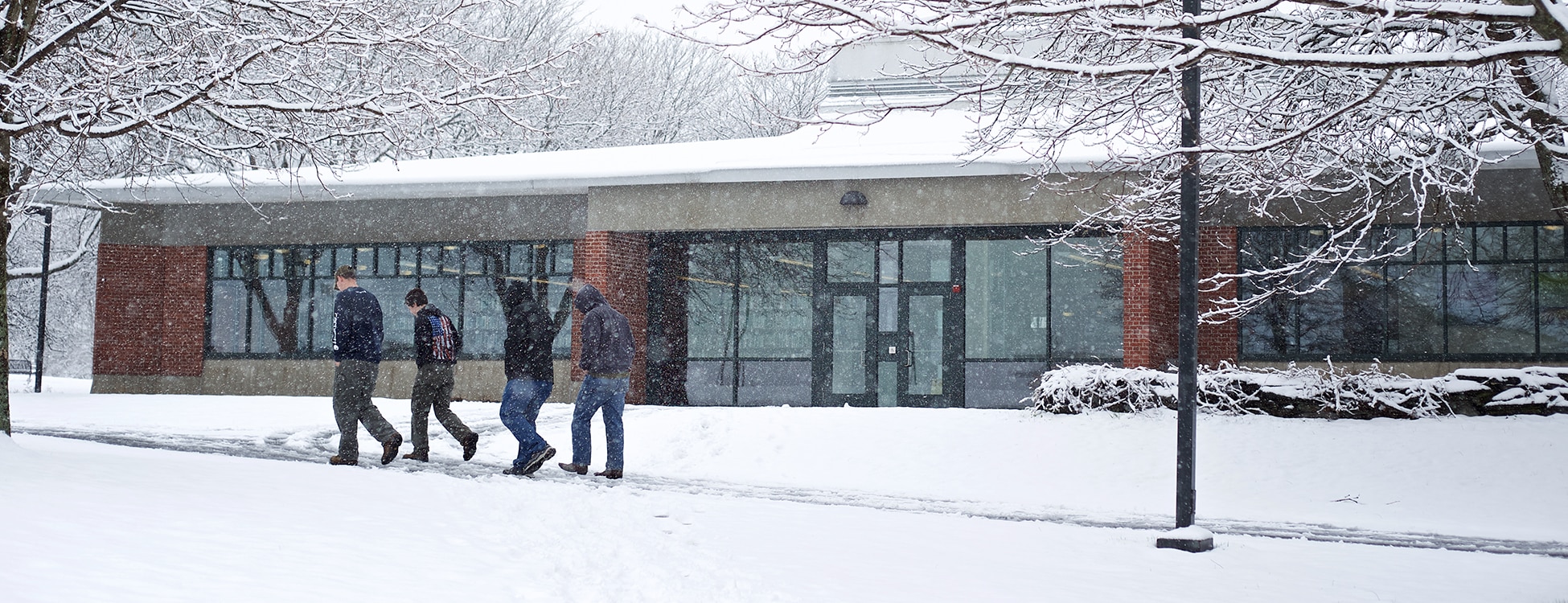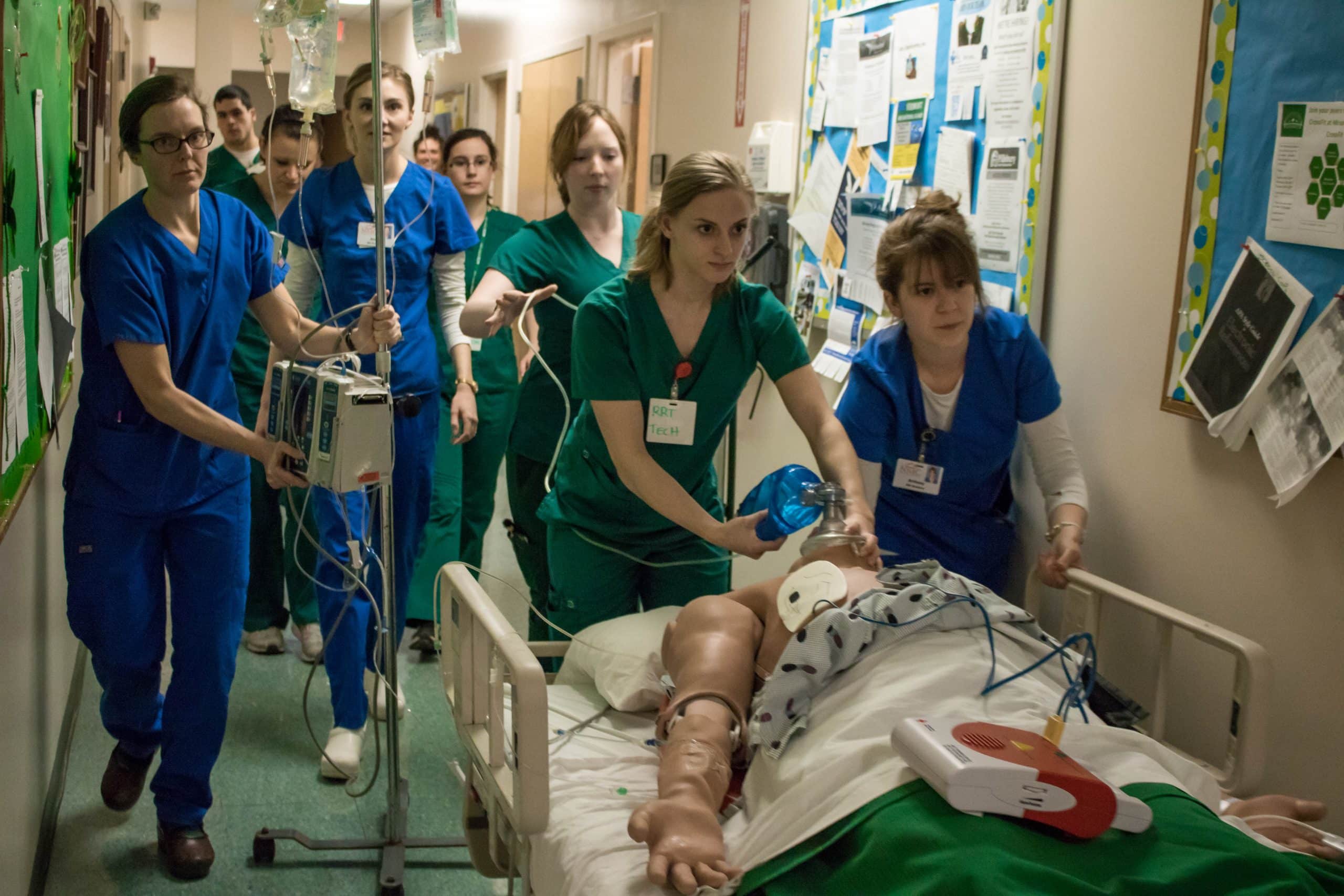

Vermont Technical College will join with Castleton University and Northern Vermont University to become Vermont State University on July 1, 2023. Learn more and apply for fall 2023.
Research Partnerships
ATI Nursing Education
Vermont Tech professors recently conducted a pilot study to help test a product designed to improve nursing students’ abilities to make safe decisions for patient care. Drs. Mary Hill and Michelle Stearns and staff in the simulation lab at Williston examined the effect of using an online simulation program on student performance in simulation lab administered high-fidelity scenarios. Using the Creighton Competency Evaluation Instrument (CCEI), the team compared student competencies after using ATI Nursing Education’s online virtual simulations called Real Life (RL) Clinical Reasoning Scenarios, a program designed to give students exposure to clinical situations they might not encounter during clinical rotations with actual patients. Students use of Real Life should positively impact their performance in actual practice and high-fidelity simulations. The pilot’s success has developed into a full-blown, currently ongoing study at Vermont Tech. We’re proud of the phenomenal dedication of these professors and their students to enable these experiments
Faculty/Staff Research
Michelle Stearns, DNP, MSN, RN
Simulation Program Director
Doctoral Study
Background:
Many organizations spend a great deal of money purchasing equipment but do not dedicate significant funds to faculty development related to it. Many faculty are left to “just figure it out”. They may fear technology or change which leads to resistance to the adoption of this technologic teaching modality. Effective use of high fidelity simulation in nursing education requires the faculty be comfortable and have a working knowledge of the technology involved. This quality improvement project study examined the impact of web-based faculty development on faculty comfort with high fidelity simulation.
Method:
The quasi-experimental design used voluntary surveys pre and post intervention. The intervention was web based education which provided asynchronous access to education to eliminate scheduling difficulties related to face to face faculty development events.
Results:
While positive trends were found, no statistically significant findings were discovered. This finding is similar to that of other studies that examined faculty simulation with comfort using a variety of interventions, most of which involved face-to-face time for faculty development.
Conclusion:
Online educational development had a similar impact to face-to-face development events from previous studies. Despite the lack of statistically significant findings, positive trends and data from the project led to the design and implementation of a simulation orientation program for new faculty and staff as well as the development of evidence based online resources for all faculty and staff.
Mary K Hill, DNP, MSN, RN-BC, OCN
Associate Professor
Doctoral Study
Title:
Can Repeat Scenario Simulation Improve Nursing Students’ Clinical Outcomes?
Background:
The demands of today’s healthcare have changed the way nursing programs prepare their students for practice. The purpose of this study was to determine if repeated simulated experiences improved nursing students’ skills.
Method:
Fifty-four nursing students in an accredited nursing program participated in a repeat scenario simulated experience. Students were observed in four core competencies in nursing: communication, technical skills, assessment, and critical thinking.
Results:
Results indicated an overall increase in knowledge of 29.4% using repeat scenarios.
Conclusion:
Repeat scenario, high-fidelity simulation has the ability to mitigate the preparation gap, facilitates the transition to practice, and enhances student outcomes.
Sherry Barnard, Ed.D, MSN, RN
Assistant Professor
Doctoral Study
Title:
Informing Effective Simulation Pedogogy in Nursing Education
Purpose of Study:
The purpose of this study was to determine faculty effectiveness in simulation and debriefing and add to the knowledge and understanding about the use of high-fidelity simulation (HFS) in nursing education as it relates to student learning.
Findings:
This study revealed five themes, which included: deliberate practice, anxiety of students, preparation of students, cueing as an intervention, and structured debriefing.
Conclusions:
Specific recommendations for faculty include providing a detailed preparation, using a variety of deliberate practice styles, using cueing to lead participants, providing a structuring debriefing, and suggestions to avoid anxiety are included in the study.
Jessica Cota, MSN, RN
Clinical Associate
Proposed Study created for MSN capstone
Title:
The Influence of Learning Environment of Undergraduate Nursing Students in the Observer Role of Simulation on Clinical Judgment Scores
Hypothesis:
The research hypothesis for this proposed research is that undergraduate nursing students observing simulation from inside the simulation lab with their actively participating peers will have increased clinical judgment scores in comparison to those observing via video conference in another room. This research hypothesis stems from the concepts expressed by Bandura in his Social Learning Theory. According to this theory, people learn from one another via observation, imitation, and modeling.
Question:
Are there differences in clinical judgment scores for undergraduate nursing students in the observer role of simulation lab who observe inside the simulation lab vs. observing via video conference in another room?
Design:
This study will use a randomized, two-group, pre-test/post-test, quasi-experimental design.
Additional Information

Simulation Program Director
We’d be happy to schedule a tour of our facilities or a meeting to discuss your educational needs and how our services can help to address them.
Michelle Stearns, DNP, MSN, RN
Simulation Program Director for Nursing and Allied Health Programs
SimProgram@vtc.edu
(802) 879-5967
